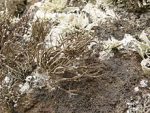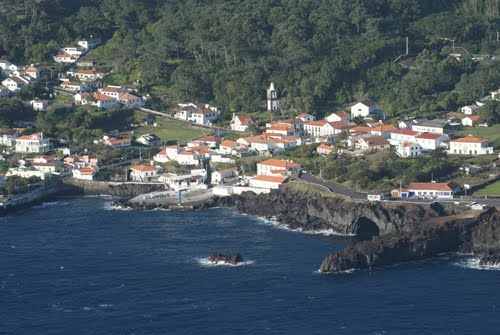 Roccella tinctoria is a fruticose perennial lichen found mostly on rocks, boulders, and cliffs along the coasts of the Mediterranean and Macronesia. It is light brown or greenish brown and consists of thin, dry, cylindrical, wavy, tapering branches that arise from a narrow base and stand 2-6″ high. Blackish wart-like fruiting structures appear at intervals along the branches. The lichen has been known since ancient times as a source of red-purple dye which the ancient Greek father of botany, Theophrastus, praised as being more beautiful than the purple that was the most highly esteemed dye of the time. The dye was used in Renaissance times in France and elsewhere to dye silk cloth. Photo Credit Wikidata
Roccella tinctoria is a fruticose perennial lichen found mostly on rocks, boulders, and cliffs along the coasts of the Mediterranean and Macronesia. It is light brown or greenish brown and consists of thin, dry, cylindrical, wavy, tapering branches that arise from a narrow base and stand 2-6″ high. Blackish wart-like fruiting structures appear at intervals along the branches. The lichen has been known since ancient times as a source of red-purple dye which the ancient Greek father of botany, Theophrastus, praised as being more beautiful than the purple that was the most highly esteemed dye of the time. The dye was used in Renaissance times in France and elsewhere to dye silk cloth. Photo Credit Wikidata
Several authorities believe that at least some of the translations “blue” for the Hebrew word t’caylet refer to a dye extracted from this lichen but this is not certain. Most commentators think that the color was the Tyrian purple mentioned in Mark 15:17 which was derived from several species of predatory sea snails known as Murex in ancient times. A moderate position on the issue is that some of the tints and shades of purple described in the Bible were obtained by blending the dyes from the lichen and the snail.
Exodus 25.4 (NKJV) God tells Moses the items he should gather from his people.
“blue, purple, and scarlet thread, fine linen, and goats’ hair;”
Exodus 26:1 (NKJV) God specifies the fine linen curtain of the tabernacle to Moses.
“Moreover thou shalt make the tabernacle with ten curtains of fine twined linen, and blue, and purple, and scarlet: with cherubim’s of cunning work shalt thou make them.”
Exodus 35: 23 (NKJV) The people bring their offerings to the tabernacle.
“And every man, with whom was found blue, purple, and scarlet thread, fine linen, and goats’ hair, red skins of rams, and badger skins, brought them.“
Exodus 39:1, 24 (NKJV) The priestly garments are made as directed by God.
1 ” Of the blue, purple, and scarlet thread they made garments of ministry, for ministering in the holy place, and made the holy garments for Aaron, as the LORD had commanded Moses.”
24 “They made on the hem of the robe pomegranates of blue, purple, and scarlet, and of fine woven linen.”
II Chronicles 3:14 (NKJV) The barrier separating the holy place from the Most Holy Place in the temple is described.
“And he made the veil of blue, purple, crimson, and fine linen, and wove cherubim into it.”
Easter 8:15 (NKJV) After King Ahasuerus makes a counter-decree allowing the Jews to protect themselves on the day scheduled for annihilation, God raises up Mordacai as the prime minister as a replacement of Haman.
“So Mordecai went out from the presence of the king in royal apparel of blue and white, with a great crown of gold and a garment of fine linen and purple; and the city of Shushan rejoiced and was glad.”
Ezekiel 27: 7 (NKJV) After receiving the prophecy regarding the fall of Tyre, Ezekiel laments the destruction of the city, portrayed as a ship.
“Fine embroidered linen from Egypt was what you spread for your sail; Blue and purple from the coasts of Elishah was what covered you.”
lichenised species of fungus in the genus Roccella, homotypic synonym of Lecanora tinctoria (DC.) Czerwiak., 1849. It was first described by Augustin Pyramus de Candolle in 1805. It has the following varieties:
- R. t. var. portentosa
- R. t. var. subpodicellata
- R. t. var. tinctoria
and formae:
- R. t. f. complanata
- R. t. f. tinctoria
Uses[edit]
It is used to make litmus, a mixture of several organic compounds.
Lichen has been used for centuries to make dyes.[1] This includes royal purple colors derived from roccella tinctoria, also known as orseille.[2] The process of making this dye was a secret and lead to the wealth of the weavers of Grainville-la-Teinturière and the Rucellai family of Florence.[3] There has been speculation that the abundance of roccella tinctoria on the Canary Islands offered a profit motive for Jean de Béthencourt during his conquest of the islands.
Orcinol, a natural phenolic organic compound, occurs in many species of lichens[4] including R. tinctoria.[1]



